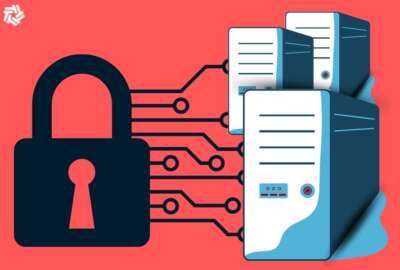GSA puts extra technology funding from pandemic recovery package into 14 IT projects
The General Services Administration recently selected 14 information technology projects in which it will invest a windfall. The GSA's technology transformation...
Best listening experience is on Chrome, Firefox or Safari. Subscribe to Federal Drive’s daily audio interviews on Apple Podcasts or PodcastOne.
The General Services Administration recently selected 14 information technology projects in which it will invest a windfall. The GSA’s Technology Transformation Service received $150 million in extra funding in fiscal 2021 from the American Rescue Plan. Technology Transformation Service Director Dave Zvenyach shared the details on Federal Drive with Tom Temin.
Interview transcript:
Tom Temin: Dave, good to have you back.
Dave Zvenyach: Great to be here. Thanks again for having me.
Tom Temin: And just begin with telling us about the projects in terms of the money. These are not all 14 GSA projects, but money you’ll be funneling to the agencies. Tell us how that all works.
Dave Zvenyach: Sure, as you mentioned, we received about $150 million as part of the American rescue Plan. And the goal for the American rescue plan was to respond to the pandemic and really think about ways that we can improve security and sort of the overall delivery of public services. And so what we’ve invested in so far are the first tranche of funding, really, to really think about how we can improve digital services delivery for the public. And as you mentioned, we have awarded 14 projects so far, everything from reimagining USA.gov, to helping with the emergency rental assistance program to child tax credit and beyond. Really trying to invest in things that are gonna have a high impact for the public and, like I said, respond to the pandemic.
Tom Temin: And how does this money relate or correspond to the technology modernization fund dollars, because a lot of these were already getting some of that money, also. This is a different type of fund, but it seems almost like the same purpose.
Dave Zvenyach: Sure. So the technology modernization fund received about a billion dollars as part of the same American Rescue Plan. And those things are also thinking about modernization. They’re also thinking about security. But this Federal Citizen Services Fund, which is the $150 million that we’re referring to here, is really focused on public facing digital services, really thinking about the differences, thinking that TMF has to go to shared services, thinking about going to other agencies for modernization. We’re really thinking about high impact public experience. And that’s been the nature of the different types of funding. But we certainly work in coordination with TMF and others.
Tom Temin: So that ties basically into the Biden administration’s CX kind of initiative, as opposed to the executive order on cybersecurity. But you must have security as part of this also.
Dave Zvenyach: That’s right. And one of the lessons that I think we really learned throughout the pandemic and before is that ultimately, the public doesn’t need to really understand the nuances and the intricacies of how government works. They just expect service delivery to happen and expect it to happen in a way that makes sense to the public. And what we are trying to do with GTS, and working with the White House and others as part of the customer experience push, is to really think about how we can improve service delivery in a way that actually makes sense to people, as opposed to doing it in a way that makes sense to agencies.
Tom Temin: And you have put these projects for purposes of public consumption into three basic buckets here: recover, rebuild and reimagine. And let’s talk about recovery, what is needing recovery?
Dave Zvenyach: Sure. So there were a number of programs that came out of the American Rescue Plan, things like the child tax credit, things like the emergency rental assistance program and the like that we really wanted to make sure that we were getting in, helping those agencies and helping make sure that we get services.
Tom Temin: So it’s American recovery, not recovery of disasters programs?
Dave Zvenyach: Correct, yeah. So the idea is that we’re recovering from the pandemic, and then we’re rebuilding digital services for a future, and then also taking the opportunity to really reimagine what digital service delivery can look like.
Tom Temin: And one of those under reimagine is reimagining the usa.gov as the front door to government. That’s what it was originally built to be, I think, maybe as far back as the Clinton administration, if I recall correctly. And GSA ran a series of ads for years impersonating Abraham Lincoln extolling the virtues of usa.gov. I don’t know whether you were around when it ran.
Dave Zvenyach: Sure, and it was firstgov.gov.
Tom Temin: Firstgov, correct. So what’s going on with that particular one? Because that’s been a project that’s been abiding, but I guess it kind of stales unless you keep refreshing it.
Dave Zvenyach: Yeah, I draw sort of a line all the way back over 50 years ago to the Consumer Information Center in the Federal Information Centers, and the idea that we’re trying to provide better services to the public. Again, helping people get stuff done is really the thing. You know, our boss, Administrator Carnahan, talks about making the damn websites work. And that’s kind of our point, like people expect services to get delivered. And we really think about USA.gov as a place for the public to be able to access public services in a way that’s sensible to them. And thinking about having a seamless, simple interface to access these government services is really the goal for the reimagining effort.
Tom Temin: We’re speaking with David Zvenyach, deputy commissioner for the Federal Acquisition Service and director of the Technology Transformation Service at the GSA. And there’s a lot of work to be done. This is Coding, essentially, what will be happening. Who is doing that work? Do some of these projects already have contractors? There’s 18F, there’s U.S. Digital Service, there’s no dearth of places to turn for the work. What do you envision?
Dave Zvenyach: That’s right. So it’s a whole group of folks that are both federal employees within GSA, federal employees outside of GSA, contractors, the public. And really just focusing on bringing all of the different people to bear with whatever their particular skill set is. You know, there’s a term that I like to use is a “badgeless culture.” Whether they’re a contractor or a fed, we’re all on the same team, trying to make sure that we’re delivering effectively. And one of the things that I think is really important about the work that we’re trying to do is we’re trying to think about how we can improve both the equity and access of our programs as well. So it really requires understanding and doing sort of deep public-facing user research, getting to understand how people are actually using these services, getting iterative feedback from them and then improving our service. along the way. So it’s not just hands on keyboard, it’s everything from product management, design, data science, all the way through and taking the best from within government and outside of governments to deliver.
Tom Temin: So getting back to usa.gov, can we expect a major overhaul of that?
Dave Zvenyach: Yes.
Tom Temin: And in the back end, then, to make it the front door to the government, there’s so much linkage that has to occur to other agencies. So you can put a new face on it, but that’s only the beginning, right? There’s so much deep work in the interconnections.
Dave Zvenyach: That’s right. And that’s why it’s going to take a whole-of-government approach to make sure that we deliver the services, I like to talk about the idea of having no wrong door. You’ve heard about the federal front door. But it really should be no wrong door. It’s that the public should be able to come into any agency and be able to get the services that they need. And so we need to be thinking about how we can create a usa.gov and sort of the constellation of efforts so that if people come in through the wrong door, they still get the services that they expect. That’s something that I think we are poised and trying to work really hard with our partners to deliver. But it is not just a GSA thing, It is really a whole-of-government effort.
Tom Temin: And we should say they’re not all coding and software design. There’s one project here building a talent pipeline for government technologists. And there’s the Presidential Fellows Program, there’s 18F, what do you envision happening there, and and who’s the lead agency on that?
Dave Zvenyach: Sure. So that is the U.S. digital core effort. I was actually here talking about that not too long ago. So we put together the US digital core to think about the next generation of technologists. We recently closed our first application for those technologists, and I believe we had something like over 1000 applicants, which is really incredible for the first 30 roles.
Tom Temin: And these are for term employment?
Dave Zvenyach: That’s correct. So these are going to be folks who are going to be working on high impact projects with other agencies. They are new to government and entry level technologists. So it’s really exciting to have that next generation of talent coming into government and thinking about this as part of the really the opportunity to have not just what the systems that we need for today, but really think about what we need for tomorrow as well.
Tom Temin: It’s almost government as gig employer in some ways.
Dave Zvenyach: I don’t like to think that. My expectation is that many of these fellows will continue to stay on and be full-time, permanent federal employees.
Tom Temin: And there’s one, I confess, I don’t understand the terminology — spurring innovation through 10x investments.
Dave Zvenyach: Yeah, we have this program called 10x. And 10x is modeled off of what you would see in the private sector as like a venture capital type fund. And it’s really thinking about taking a phased approach to innovation. So 10x has spurred programs like login.gov, and the U.S. web design system and others. And the idea of 10x is you take an idea, you see if it’s good — and oftentimes you first see if it’s bad — and then you take it all the way through testing and sort of different phases to see whether or not something can scale. So 10x is an opportunity as we think about reimagining digital services. Just take speculative wild ideas from anywhere across the government and see if it might be able to stick and improve service delivery.
Tom Temin: Now it’s relatively easy to take in money from, say, the American Rescue Plan and decide here’s where it goes and distribute it. But then there is the accountability piece that you have to know that the projects are happening, that the milestones are being met. What are the mechanisms built in to track these projects? So that there’s some closure on it all?
Dave Zvenyach: Such a great question. And actually, I think that’s one of the things that we really pride ourselves on within TTS. It’s that we think about these projects not just in terms of, okay, we’ve got $150 million, let’s spend it. But think about how we can get the most return on investment for those dollars. And that’s where programs like 10x have really excelled. Not only because they have great ideas, but they actually kill a lot of bad ideas. And we find that’s true, too, is that you’re going to spend some projects that seem like they’re great. When you get into it a little bit, you say, no, that’s not going to work, or it’s not really returning the types of results that we want, and shut them down. And so when we think about these first 14 projects on the American Rescue Plan, and then also with the 10x program and beyond, the goal is not necessarily for every project to be wildly successful. We expect to get a few home runs through the effort.
Tom Temin: And would you say that’s an emerging trend in the way government approaches these types of projects is much smaller time horizons and much faster trigger to kill off projects that aren’t going right? As opposed to, gee, five years and a billion dollars, we’ve got nothing to show for it, which still happens in this day.
Dave Zvenyach: That’s right. I tend to think that the riskiest projects are the ones that end after many years without actually having tested under the assumptions at the beginning. And so we really think about how we can be iterative and incremental in terms of testing our assumptions, reducing risk and getting to better results.
Tom Temin: David’s Zvenyach is deputy commissioner for the Federal Acquisition Service, and director of the Technology Transformation Service at the GSA. Thanks so much for joining me.
Dave Zvenyach: Absolutely. Thanks for having me.
Copyright © 2024 Federal News Network. All rights reserved. This website is not intended for users located within the European Economic Area.
Tom Temin is host of the Federal Drive and has been providing insight on federal technology and management issues for more than 30 years.
Follow @tteminWFED






